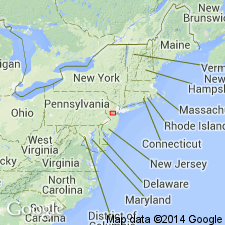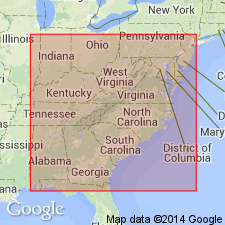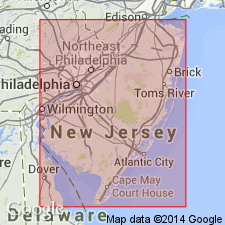
- Usage in publication:
-
- Cohansey sand
- Modifications:
-
- Named
- Dominant lithology:
-
- Sand
- Clay
- AAPG geologic province:
-
- Atlantic Coast basin
Summary:
Coarse quartz sand with occasional small pebbles occurring along Cohansey Creek in Cumberland Co., here referred to as Cohansey sand. Locally cemented into sandstone. Contains clay lenses 8 to 24 ft thick. Rests on Shiloh marl [member of Kirkwood formation]. Underlies Beacon Hill gravel and was included in Beacon Hill by Salisbury (1894). [Later reports give thickness as 450+/-ft.]
Source: GNU records (USGS DDS-6; Reston GNULEX).

- Usage in publication:
-
- Cohansey Sand*
- Modifications:
-
- Overview
- AAPG geologic province:
-
- Atlantic Coast basin
Summary:
Only the lower, middle Miocene part shown on lithologic sections in NJ as Cohansey Sand. Correlation with calcareous nannofossil zones is unknown here. Report includes fossil lists and stratigraphic/ lithologic sections.
Source: GNU records (USGS DDS-6; Reston GNULEX).

- Usage in publication:
-
- Cohansey Formation*
- Modifications:
-
- Revised
- AAPG geologic province:
-
- Atlantic Coast basin
Summary:
The Cohansey is revised to the Cohansey Formation. Consists of fine- to coarse-grained, locally gravelly, massive to cross-bedded, gray brown or dark gray, yellow to white weathered sand with interbedded thin to thick, finely laminated clay or silty clay. Thickness reaches 61 meters in outcrop and 70 meters in subsurface. Overlies the Wildwood Formation, Shiloh Marl, or Kirkwood Formation and is commonly found in channels cut into underlying units. The Cohansey is of middle Miocene (Serravallian) age.
Source: GNU records (USGS DDS-6; Reston GNULEX).
For more information, please contact Nancy Stamm, Geologic Names Committee Secretary.
Asterisk (*) indicates published by U.S. Geological Survey authors.
"No current usage" (†) implies that a name has been abandoned or has fallen into disuse. Former usage and, if known, replacement name given in parentheses ( ).
Slash (/) indicates name conflicts with nomenclatural guidelines (CSN, 1933; ACSN, 1961, 1970; NACSN, 1983, 2005, 2021). May be explained within brackets ([ ]).

